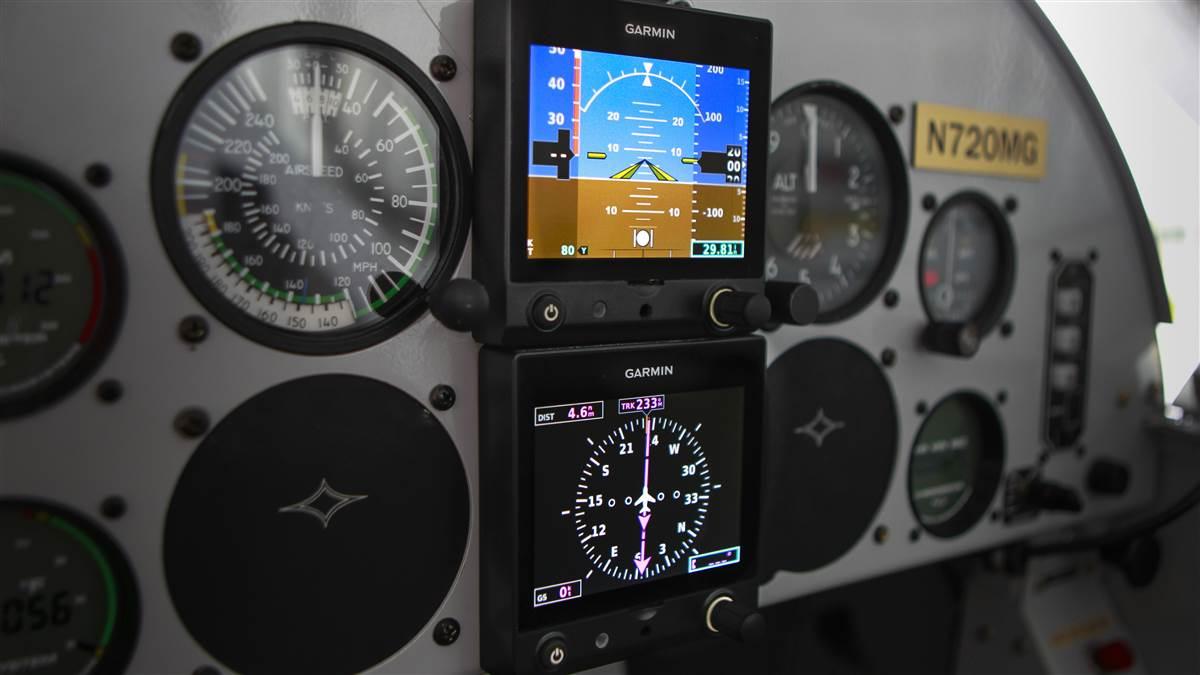Technology: Solo or in tandem
Every panel should have at least one G5

The G5 can play leading or supporting roles in any panel. And if common sense and current FAA regulatory trends prevail, the G5 may someday have access to a far broader general aviation market. The G5 can serve as a primary flight display (PFD) or horizontal situation indicator (HSI), drive a digital autopilot system, and supply flight data to Garmin G3X display in case of an in-flight failure. And what the G5 lacks in size, it more than makes up for in ease of use, simple installation, and tight integration with other Garmin equipment.
I mounted a pair of G5s in the six-pack panel of my Experimental-category Van’s Aircraft RV–3B, where they serve as a primary display (attitude, airspeed, barometric altitude, and ground track) and HSI (showing WAAS GPS from an aera 660 portable GPS). The HSI can display signals from panel-mount or portable GPS, or a nav radio, but it can only be connected to one unit at a time. The installation was a snap as the two front-mounted units fit securely into Garmin-supplied mounting rings in the two holes where a traditional attitude indicator and directional gyro used to reside.
Each G5 has a nine-pin connector that supplies aviation data from external GPS or nav radio, as well as electrical power, and pitot-static air lines. G5s also have a built-in GPS and air data computer, and an optional lithium battery can power them up to four hours if ship’s power is ever lost.
Interestingly, Garmin purposely developed unique software and sensors for the G5 so that an unforeseen fault can’t take down linked avionics. In the air, the G5s look and act much like existing FAA-certified PFD/HSI combinations that cost at least four times as much. The differences are that the G5s have brighter, higher resolution screens (320 by 240 pixels) and, with fewer button combinations, are easier to use. With an old, but IFR-approved, Garmin GNC 300XL feeding position information to one of the G5s, intercepting and tracking GPS approaches felt familiar. The magenta-colored HSI counted down the time and distance to each turn, and needle sensitivity remained constant and easy to follow. With a WAAS-enabled, portable aera 660 linked to the other G5, it provided vertical and lateral guidance.
The G5s can be linked to a nav radio tuned to an ILS frequency, and the radio signals appear as green needles on the HSI displaying old-school localizer and glideslope—with no moving mechanical parts, like a traditional HSI. (The G5 also can drive Garmin’s Experimental autopilot system and backfill the integrated G3X avionics suite, but I had no way to evaluate those capabilities on my hand-flown, mostly round-dial airplane.)
The G5 can operate independently as an all-in-one standby gauge, team up with a second G5 in a PFD/HSI combo, or link to an integrated G3X system. Garmin is mum on its future plans for the G5, but it’s easy to imagine the chameleon-like G5 taking on many other functions. A moving map? Synthetic vision? A dedicated traffic page? Engine monitor? Angle of attack indicator? All it takes is software, and that’s Garmin’s strong suit.
The G5’s biggest shortcoming has nothing to do with the box itself. It’s the current FAA barrier to installing them in FAA-certified aircraft. With rival Dynon’s recent watershed victory at getting FAA approval for the company’s non-TSOed D-10A EFIS in certain Cessna and Piper singles via STC, perhaps the way to the broader GA fleet has been cleared for Garmin and its G5. Let’s hope so. There are thousands of legacy airplanes with round-dial panels that could quickly and economically become safer, more reliable, and more enjoyable to fly with this sort of technology at their core.
Email [email protected]



